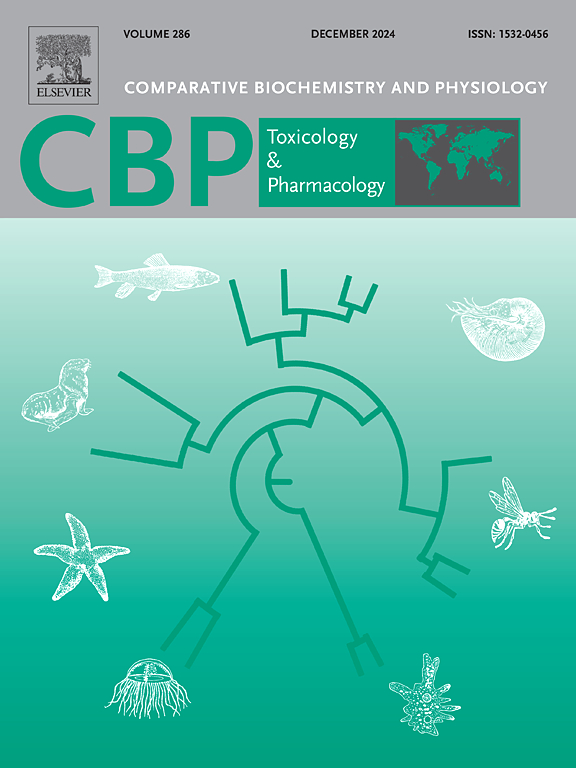玉米赤霉烯酮(ZEN)通过炎症途径损害运动功能并诱导神经毒性:来自斑马鱼模型和分子对接研究的证据
IF 3.9
3区 环境科学与生态学
Q2 BIOCHEMISTRY & MOLECULAR BIOLOGY
Comparative Biochemistry and Physiology C-toxicology & Pharmacology
Pub Date : 2025-03-15
DOI:10.1016/j.cbpc.2025.110194
引用次数: 0
摘要
ZEN是一种低分子量的食品污染物,由于其高热稳定性和持久性,在各种作物和地区经常被检测到。它对生物神经系统构成了重大威胁。然而,zen诱导的神经毒性的分子机制仍然不完全清楚。为了进一步探讨这一问题,本研究将重点关注ZEN对神经系统的影响,特别是其关键靶点和相关分子机制。本研究结合网络毒理学和分子对接方法,对接触ZEN的斑马鱼幼虫进行行为分析。首先,运动能力测试显示,在光周期和暗周期中,ZEN暴露显著降低了斑马鱼幼虫的整体运动速度。然后,我们从GeneCards、OMIM和DrugBank数据库中确定了141个与禅宗诱导的神经毒性相关的潜在靶点。通过STRING和Cytoscape软件进一步筛选,提取了25个关键节点,包括TP53、AKT1、CASP3、MAPK3和NFKB1。对GO和KEGG通路的分析发现了20条最相关的信号通路,并表明zen诱导的神经毒性的核心靶点主要涉及炎症通路。利用AutoDock进行分子对接进一步证实了ZEN与靶点之间的强结合亲和力。6种核心靶蛋白均与ZEN具有较强的结合亲和力,结合能均小于−7。总之,本研究结果表明,ZEN可能通过激活神经炎症信号通路影响认知功能障碍和神经病变,最终导致神经元死亡。这项研究为ZEN诱导的神经毒性的分子机制提供了重要的见解,并强调了与暴露于ZEN和类似食品污染物相关的疾病的预防和治疗潜力。本文章由计算机程序翻译,如有差异,请以英文原文为准。

Zearalenone (ZEN) impairs motor function and induces neurotoxicity via inflammatory pathways: Evidence from zebrafish models and molecular docking studies
ZEN is a low-molecular-weight food contaminant that is frequently detected in various crops and regions due to its high thermal stability and persistence. It poses a significant threat to the biological nervous system. However, the molecular mechanisms underlying ZEN-induced neurotoxicity remain incompletely understood. To further explore this issue, this study focused on the effects of ZEN on the nervous system, particularly its key targets and related molecular mechanisms. The study combined network toxicology and molecular docking methods and performed behavioral analysis of zebrafish larvae exposed to ZEN.
Firstly, motor capacity tests revealed that ZEN exposure significantly reduced the overall movement speed of zebrafish larvae during both photoperiod and dark cycles. We then identified 141 potential targets associated with ZEN-induced neurotoxicity from the GeneCards, OMIM, and DrugBank databases. Further screening using STRING and Cytoscape software extracted 25 key nodes, including TP53, AKT1, CASP3, MAPK3, and NFKB1. Analysis of GO and KEGG pathways suggested 20 of the most relevant signaling pathways and indicated that the core targets of ZEN-induced neurotoxicity were primarily involved in inflammatory pathways. Molecular docking using AutoDock further confirmed the strong binding affinity between ZEN and the targets. All six core target proteins exhibited strong binding affinity with ZEN, with binding energies of less than −7.
In summary, the results of this study suggest that ZEN may impact cognitive dysfunction and neuropathy by activating neuroinflammatory signaling pathways, ultimately leading to neuronal death. This study provides important insights into the molecular mechanisms of ZEN-induced neurotoxicity and highlights the potential for prevention and treatment of diseases associated with exposure to ZEN and similar food contaminants.
求助全文
通过发布文献求助,成功后即可免费获取论文全文。
去求助
来源期刊
CiteScore
7.50
自引率
5.10%
发文量
206
审稿时长
30 days
期刊介绍:
Part C: Toxicology and Pharmacology. This journal is concerned with chemical and drug action at different levels of organization, biotransformation of xenobiotics, mechanisms of toxicity, including reactive oxygen species and carcinogenesis, endocrine disruptors, natural products chemistry, and signal transduction with a molecular approach to these fields.

 求助内容:
求助内容: 应助结果提醒方式:
应助结果提醒方式:


